Newspaper Analysis: The Great Barrier Reef and Environmental Threats
VerifiedAdded on 2020/03/02
|6
|1440
|59
Report
AI Summary
This report analyzes a newspaper article discussing the environmental challenges facing the Great Barrier Reef. The article highlights the impact of climate change, including rising sea temperatures and coral bleaching, and the detrimental effects of human activities such as agriculture, coal mining, and dredging. The analysis explores the economic implications of the reef's degradation, particularly its impact on tourism and fishing, which are major contributors to Australia's revenue. The report references scientific studies and government plans, such as the Reef2050 Plan, to mitigate the damage. The analysis emphasizes the need for decisive action to protect the reef and its vital role in the marine ecosystem and the Australian economy. The report uses various sources and provides a detailed overview of the Great Barrier Reef's current state and potential future. The report also highlights the importance of international agreements and conservation efforts to ensure the reef's survival.
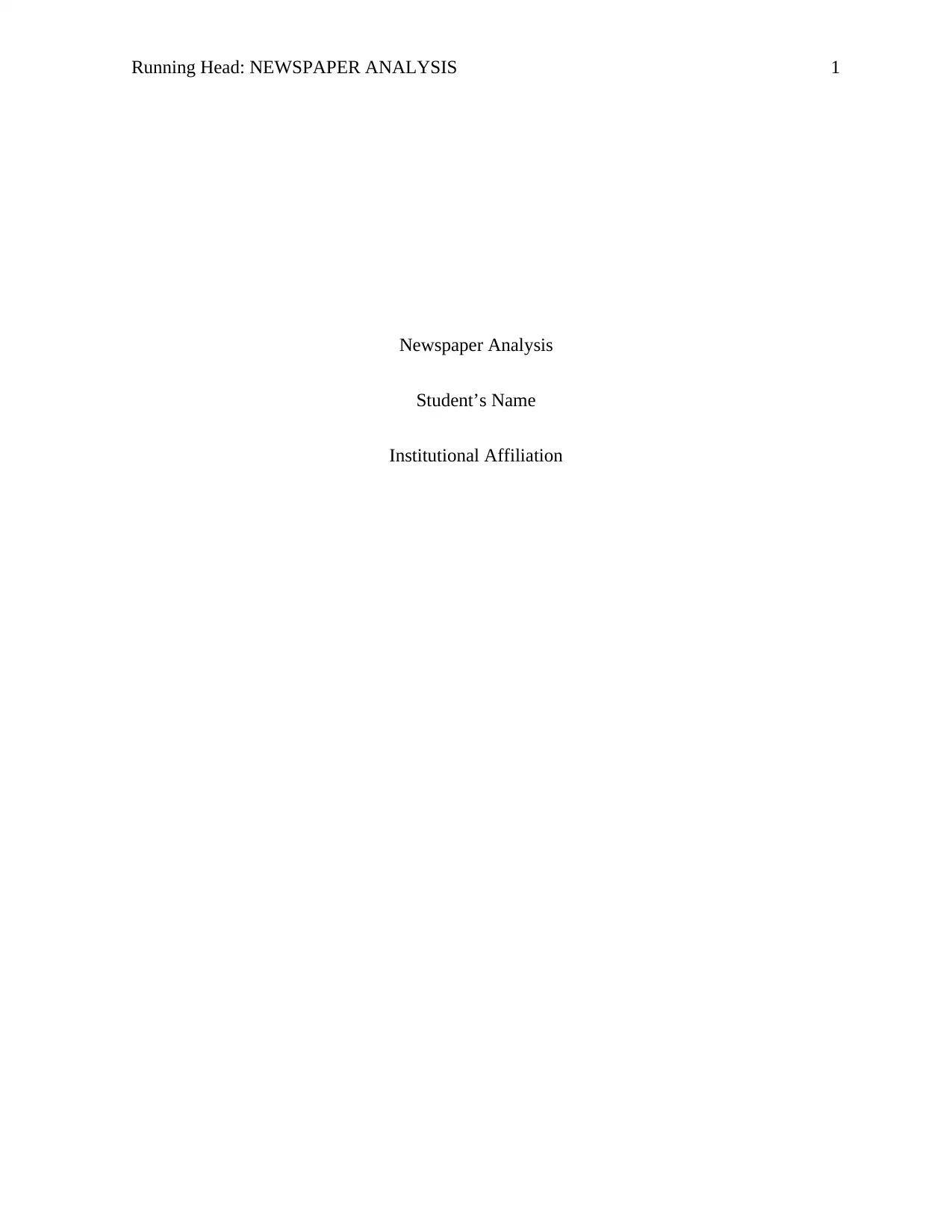
Running Head: NEWSPAPER ANALYSIS 1
Newspaper Analysis
Student’s Name
Institutional Affiliation
Newspaper Analysis
Student’s Name
Institutional Affiliation
Paraphrase This Document
Need a fresh take? Get an instant paraphrase of this document with our AI Paraphraser
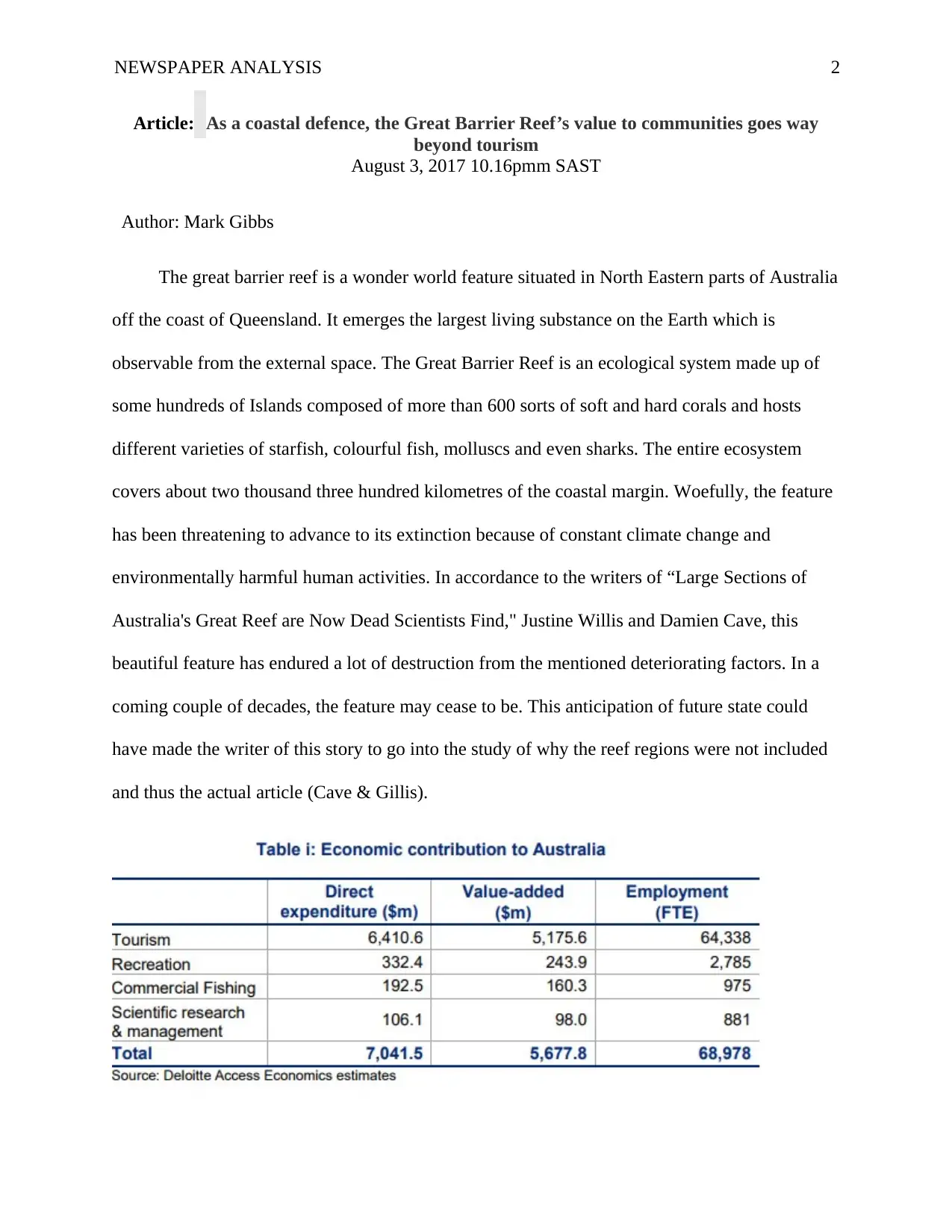
NEWSPAPER ANALYSIS 2
Article: As a coastal defence, the Great Barrier Reef’s value to communities goes way
beyond tourism
August 3, 2017 10.16pmm SAST
Author: Mark Gibbs
The great barrier reef is a wonder world feature situated in North Eastern parts of Australia
off the coast of Queensland. It emerges the largest living substance on the Earth which is
observable from the external space. The Great Barrier Reef is an ecological system made up of
some hundreds of Islands composed of more than 600 sorts of soft and hard corals and hosts
different varieties of starfish, colourful fish, molluscs and even sharks. The entire ecosystem
covers about two thousand three hundred kilometres of the coastal margin. Woefully, the feature
has been threatening to advance to its extinction because of constant climate change and
environmentally harmful human activities. In accordance to the writers of “Large Sections of
Australia's Great Reef are Now Dead Scientists Find," Justine Willis and Damien Cave, this
beautiful feature has endured a lot of destruction from the mentioned deteriorating factors. In a
coming couple of decades, the feature may cease to be. This anticipation of future state could
have made the writer of this story to go into the study of why the reef regions were not included
and thus the actual article (Cave & Gillis).
Article: As a coastal defence, the Great Barrier Reef’s value to communities goes way
beyond tourism
August 3, 2017 10.16pmm SAST
Author: Mark Gibbs
The great barrier reef is a wonder world feature situated in North Eastern parts of Australia
off the coast of Queensland. It emerges the largest living substance on the Earth which is
observable from the external space. The Great Barrier Reef is an ecological system made up of
some hundreds of Islands composed of more than 600 sorts of soft and hard corals and hosts
different varieties of starfish, colourful fish, molluscs and even sharks. The entire ecosystem
covers about two thousand three hundred kilometres of the coastal margin. Woefully, the feature
has been threatening to advance to its extinction because of constant climate change and
environmentally harmful human activities. In accordance to the writers of “Large Sections of
Australia's Great Reef are Now Dead Scientists Find," Justine Willis and Damien Cave, this
beautiful feature has endured a lot of destruction from the mentioned deteriorating factors. In a
coming couple of decades, the feature may cease to be. This anticipation of future state could
have made the writer of this story to go into the study of why the reef regions were not included
and thus the actual article (Cave & Gillis).
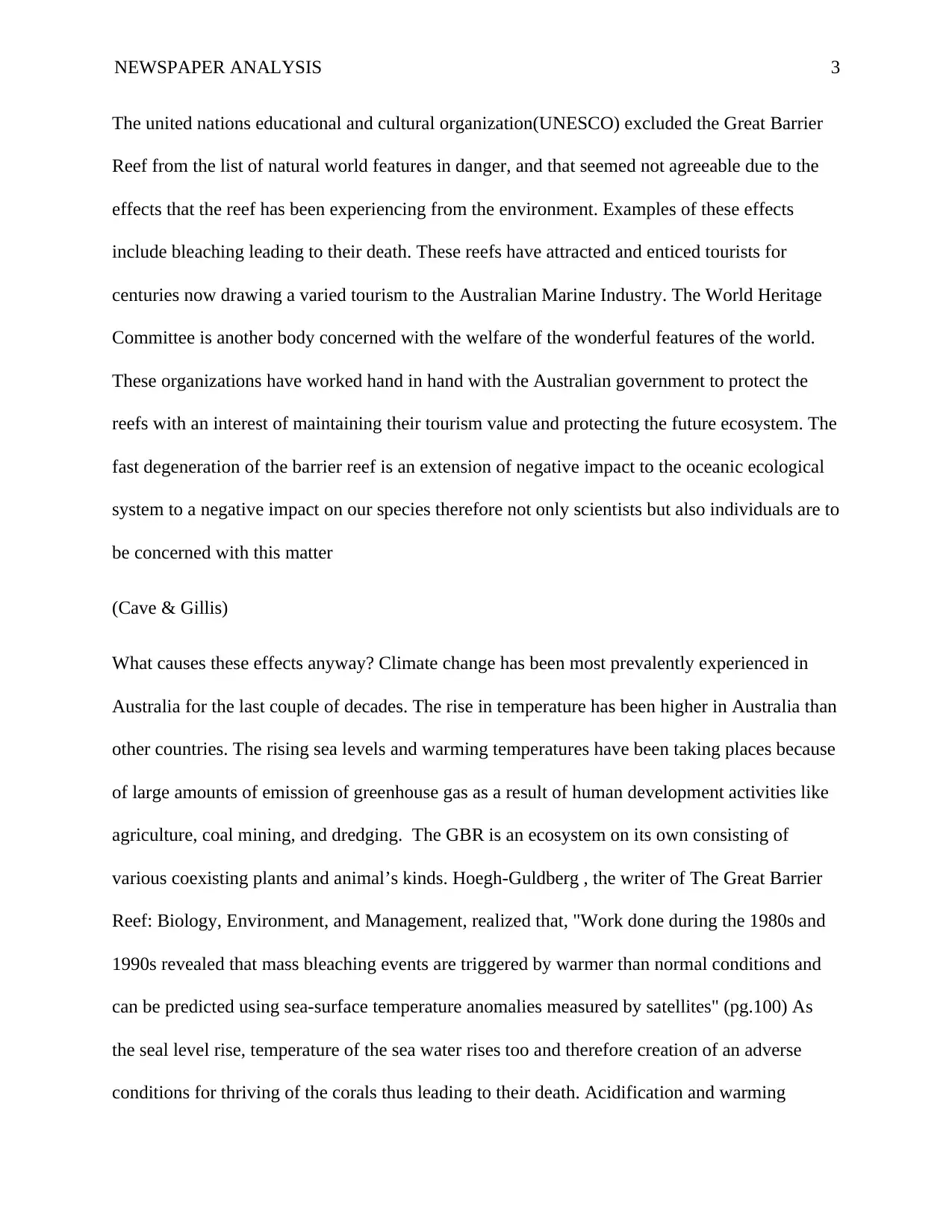
NEWSPAPER ANALYSIS 3
The united nations educational and cultural organization(UNESCO) excluded the Great Barrier
Reef from the list of natural world features in danger, and that seemed not agreeable due to the
effects that the reef has been experiencing from the environment. Examples of these effects
include bleaching leading to their death. These reefs have attracted and enticed tourists for
centuries now drawing a varied tourism to the Australian Marine Industry. The World Heritage
Committee is another body concerned with the welfare of the wonderful features of the world.
These organizations have worked hand in hand with the Australian government to protect the
reefs with an interest of maintaining their tourism value and protecting the future ecosystem. The
fast degeneration of the barrier reef is an extension of negative impact to the oceanic ecological
system to a negative impact on our species therefore not only scientists but also individuals are to
be concerned with this matter
(Cave & Gillis)
What causes these effects anyway? Climate change has been most prevalently experienced in
Australia for the last couple of decades. The rise in temperature has been higher in Australia than
other countries. The rising sea levels and warming temperatures have been taking places because
of large amounts of emission of greenhouse gas as a result of human development activities like
agriculture, coal mining, and dredging. The GBR is an ecosystem on its own consisting of
various coexisting plants and animal’s kinds. Hoegh-Guldberg , the writer of The Great Barrier
Reef: Biology, Environment, and Management, realized that, "Work done during the 1980s and
1990s revealed that mass bleaching events are triggered by warmer than normal conditions and
can be predicted using sea-surface temperature anomalies measured by satellites" (pg.100) As
the seal level rise, temperature of the sea water rises too and therefore creation of an adverse
conditions for thriving of the corals thus leading to their death. Acidification and warming
The united nations educational and cultural organization(UNESCO) excluded the Great Barrier
Reef from the list of natural world features in danger, and that seemed not agreeable due to the
effects that the reef has been experiencing from the environment. Examples of these effects
include bleaching leading to their death. These reefs have attracted and enticed tourists for
centuries now drawing a varied tourism to the Australian Marine Industry. The World Heritage
Committee is another body concerned with the welfare of the wonderful features of the world.
These organizations have worked hand in hand with the Australian government to protect the
reefs with an interest of maintaining their tourism value and protecting the future ecosystem. The
fast degeneration of the barrier reef is an extension of negative impact to the oceanic ecological
system to a negative impact on our species therefore not only scientists but also individuals are to
be concerned with this matter
(Cave & Gillis)
What causes these effects anyway? Climate change has been most prevalently experienced in
Australia for the last couple of decades. The rise in temperature has been higher in Australia than
other countries. The rising sea levels and warming temperatures have been taking places because
of large amounts of emission of greenhouse gas as a result of human development activities like
agriculture, coal mining, and dredging. The GBR is an ecosystem on its own consisting of
various coexisting plants and animal’s kinds. Hoegh-Guldberg , the writer of The Great Barrier
Reef: Biology, Environment, and Management, realized that, "Work done during the 1980s and
1990s revealed that mass bleaching events are triggered by warmer than normal conditions and
can be predicted using sea-surface temperature anomalies measured by satellites" (pg.100) As
the seal level rise, temperature of the sea water rises too and therefore creation of an adverse
conditions for thriving of the corals thus leading to their death. Acidification and warming
⊘ This is a preview!⊘
Do you want full access?
Subscribe today to unlock all pages.

Trusted by 1+ million students worldwide
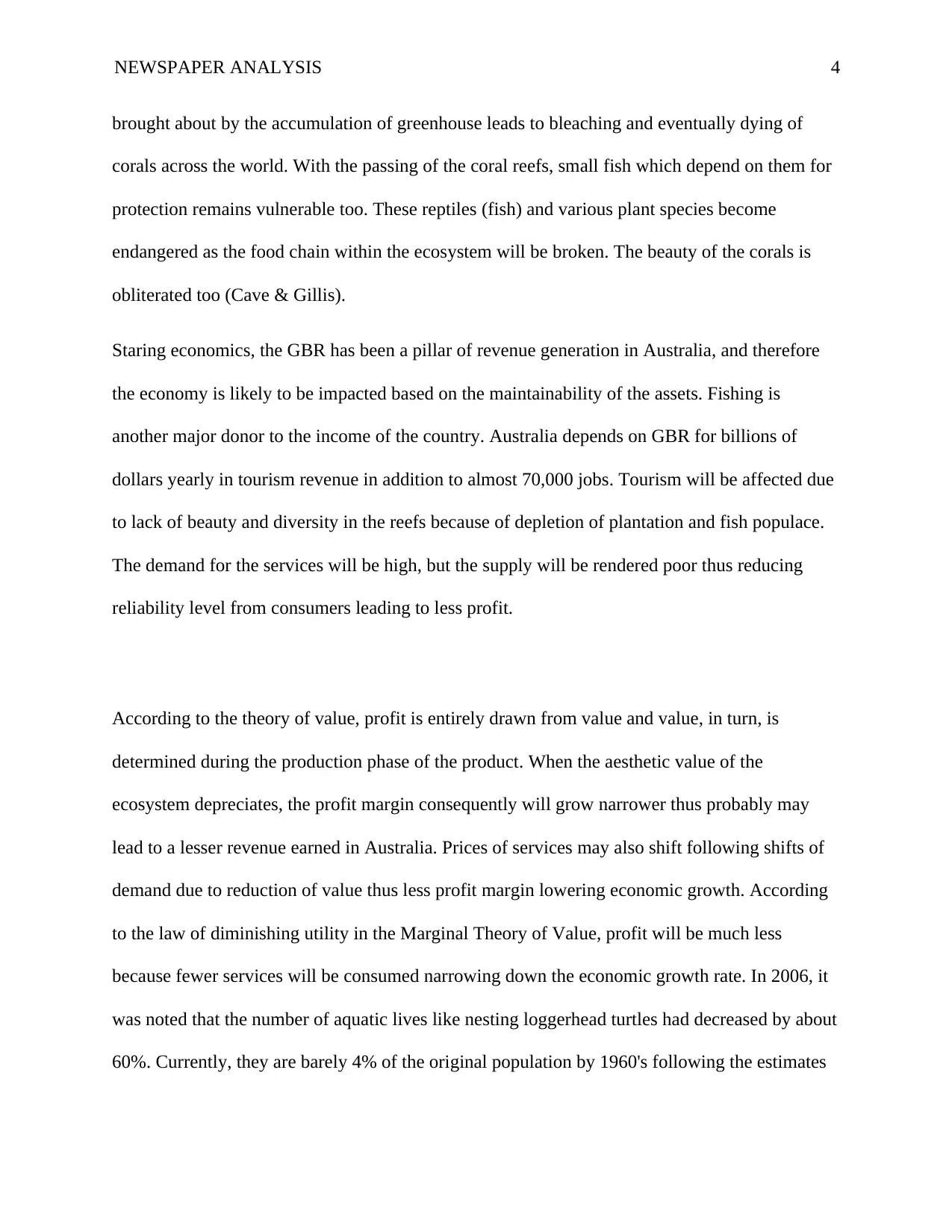
NEWSPAPER ANALYSIS 4
brought about by the accumulation of greenhouse leads to bleaching and eventually dying of
corals across the world. With the passing of the coral reefs, small fish which depend on them for
protection remains vulnerable too. These reptiles (fish) and various plant species become
endangered as the food chain within the ecosystem will be broken. The beauty of the corals is
obliterated too (Cave & Gillis).
Staring economics, the GBR has been a pillar of revenue generation in Australia, and therefore
the economy is likely to be impacted based on the maintainability of the assets. Fishing is
another major donor to the income of the country. Australia depends on GBR for billions of
dollars yearly in tourism revenue in addition to almost 70,000 jobs. Tourism will be affected due
to lack of beauty and diversity in the reefs because of depletion of plantation and fish populace.
The demand for the services will be high, but the supply will be rendered poor thus reducing
reliability level from consumers leading to less profit.
According to the theory of value, profit is entirely drawn from value and value, in turn, is
determined during the production phase of the product. When the aesthetic value of the
ecosystem depreciates, the profit margin consequently will grow narrower thus probably may
lead to a lesser revenue earned in Australia. Prices of services may also shift following shifts of
demand due to reduction of value thus less profit margin lowering economic growth. According
to the law of diminishing utility in the Marginal Theory of Value, profit will be much less
because fewer services will be consumed narrowing down the economic growth rate. In 2006, it
was noted that the number of aquatic lives like nesting loggerhead turtles had decreased by about
60%. Currently, they are barely 4% of the original population by 1960's following the estimates
brought about by the accumulation of greenhouse leads to bleaching and eventually dying of
corals across the world. With the passing of the coral reefs, small fish which depend on them for
protection remains vulnerable too. These reptiles (fish) and various plant species become
endangered as the food chain within the ecosystem will be broken. The beauty of the corals is
obliterated too (Cave & Gillis).
Staring economics, the GBR has been a pillar of revenue generation in Australia, and therefore
the economy is likely to be impacted based on the maintainability of the assets. Fishing is
another major donor to the income of the country. Australia depends on GBR for billions of
dollars yearly in tourism revenue in addition to almost 70,000 jobs. Tourism will be affected due
to lack of beauty and diversity in the reefs because of depletion of plantation and fish populace.
The demand for the services will be high, but the supply will be rendered poor thus reducing
reliability level from consumers leading to less profit.
According to the theory of value, profit is entirely drawn from value and value, in turn, is
determined during the production phase of the product. When the aesthetic value of the
ecosystem depreciates, the profit margin consequently will grow narrower thus probably may
lead to a lesser revenue earned in Australia. Prices of services may also shift following shifts of
demand due to reduction of value thus less profit margin lowering economic growth. According
to the law of diminishing utility in the Marginal Theory of Value, profit will be much less
because fewer services will be consumed narrowing down the economic growth rate. In 2006, it
was noted that the number of aquatic lives like nesting loggerhead turtles had decreased by about
60%. Currently, they are barely 4% of the original population by 1960's following the estimates
Paraphrase This Document
Need a fresh take? Get an instant paraphrase of this document with our AI Paraphraser
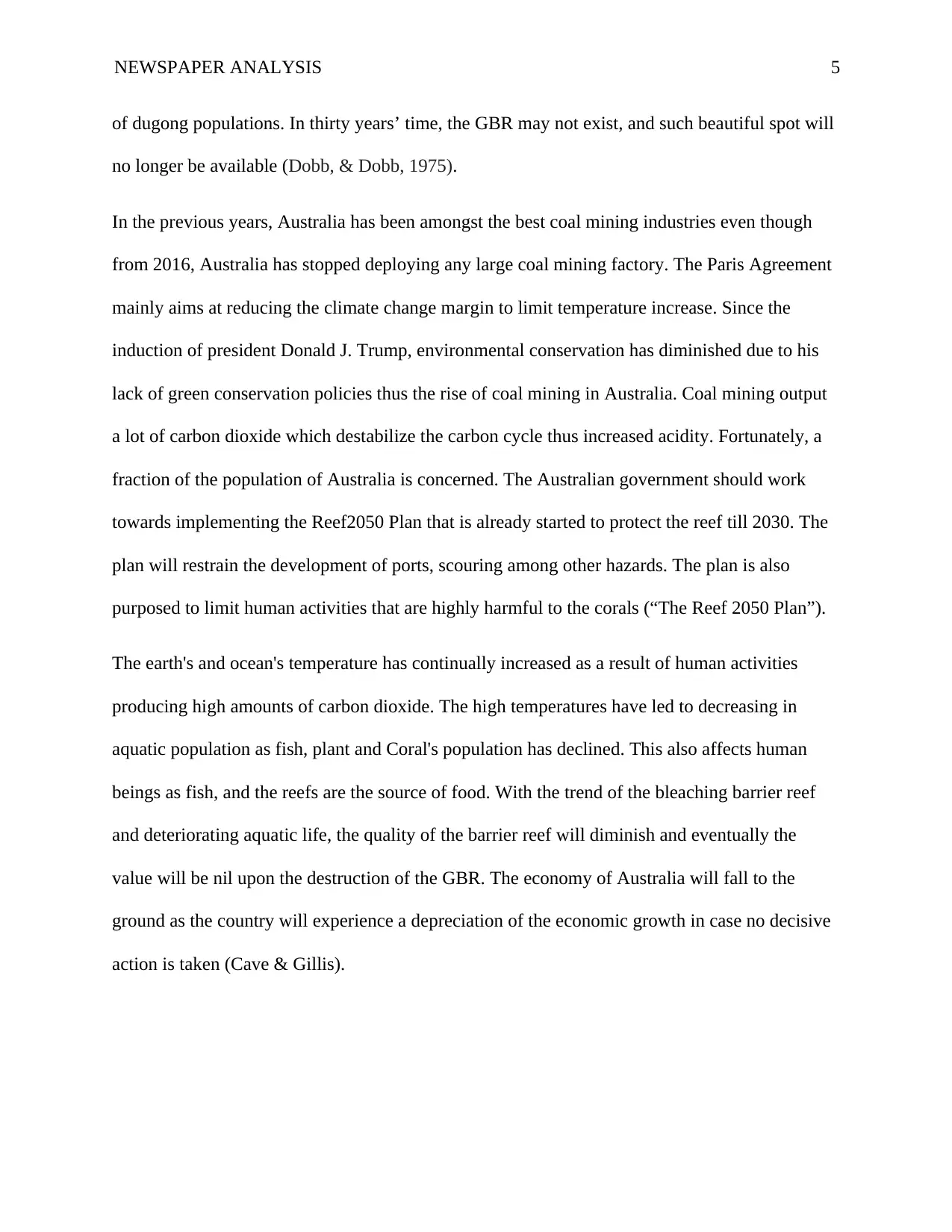
NEWSPAPER ANALYSIS 5
of dugong populations. In thirty years’ time, the GBR may not exist, and such beautiful spot will
no longer be available (Dobb, & Dobb, 1975).
In the previous years, Australia has been amongst the best coal mining industries even though
from 2016, Australia has stopped deploying any large coal mining factory. The Paris Agreement
mainly aims at reducing the climate change margin to limit temperature increase. Since the
induction of president Donald J. Trump, environmental conservation has diminished due to his
lack of green conservation policies thus the rise of coal mining in Australia. Coal mining output
a lot of carbon dioxide which destabilize the carbon cycle thus increased acidity. Fortunately, a
fraction of the population of Australia is concerned. The Australian government should work
towards implementing the Reef2050 Plan that is already started to protect the reef till 2030. The
plan will restrain the development of ports, scouring among other hazards. The plan is also
purposed to limit human activities that are highly harmful to the corals (“The Reef 2050 Plan”).
The earth's and ocean's temperature has continually increased as a result of human activities
producing high amounts of carbon dioxide. The high temperatures have led to decreasing in
aquatic population as fish, plant and Coral's population has declined. This also affects human
beings as fish, and the reefs are the source of food. With the trend of the bleaching barrier reef
and deteriorating aquatic life, the quality of the barrier reef will diminish and eventually the
value will be nil upon the destruction of the GBR. The economy of Australia will fall to the
ground as the country will experience a depreciation of the economic growth in case no decisive
action is taken (Cave & Gillis).
of dugong populations. In thirty years’ time, the GBR may not exist, and such beautiful spot will
no longer be available (Dobb, & Dobb, 1975).
In the previous years, Australia has been amongst the best coal mining industries even though
from 2016, Australia has stopped deploying any large coal mining factory. The Paris Agreement
mainly aims at reducing the climate change margin to limit temperature increase. Since the
induction of president Donald J. Trump, environmental conservation has diminished due to his
lack of green conservation policies thus the rise of coal mining in Australia. Coal mining output
a lot of carbon dioxide which destabilize the carbon cycle thus increased acidity. Fortunately, a
fraction of the population of Australia is concerned. The Australian government should work
towards implementing the Reef2050 Plan that is already started to protect the reef till 2030. The
plan will restrain the development of ports, scouring among other hazards. The plan is also
purposed to limit human activities that are highly harmful to the corals (“The Reef 2050 Plan”).
The earth's and ocean's temperature has continually increased as a result of human activities
producing high amounts of carbon dioxide. The high temperatures have led to decreasing in
aquatic population as fish, plant and Coral's population has declined. This also affects human
beings as fish, and the reefs are the source of food. With the trend of the bleaching barrier reef
and deteriorating aquatic life, the quality of the barrier reef will diminish and eventually the
value will be nil upon the destruction of the GBR. The economy of Australia will fall to the
ground as the country will experience a depreciation of the economic growth in case no decisive
action is taken (Cave & Gillis).
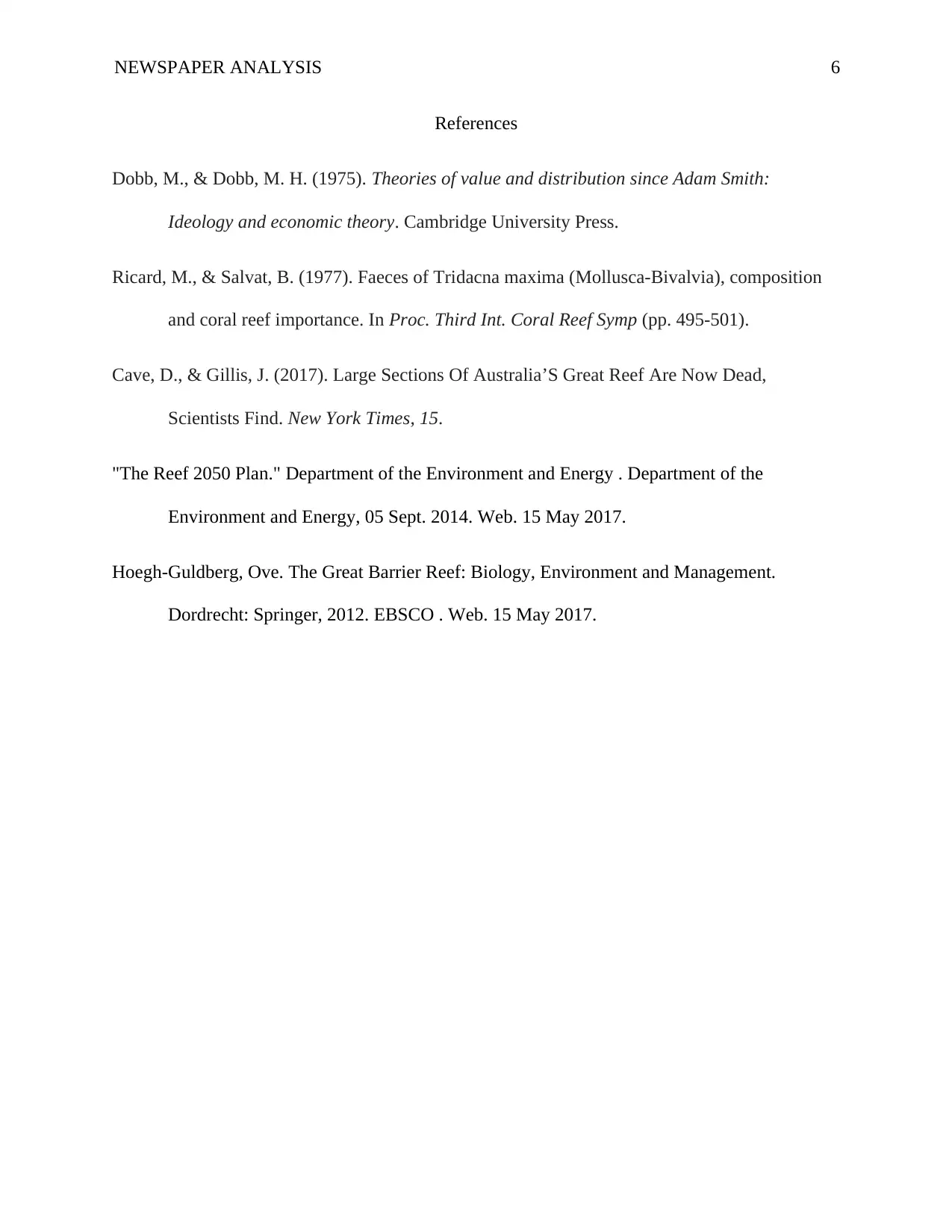
NEWSPAPER ANALYSIS 6
References
Dobb, M., & Dobb, M. H. (1975). Theories of value and distribution since Adam Smith:
Ideology and economic theory. Cambridge University Press.
Ricard, M., & Salvat, B. (1977). Faeces of Tridacna maxima (Mollusca-Bivalvia), composition
and coral reef importance. In Proc. Third Int. Coral Reef Symp (pp. 495-501).
Cave, D., & Gillis, J. (2017). Large Sections Of Australia’S Great Reef Are Now Dead,
Scientists Find. New York Times, 15.
"The Reef 2050 Plan." Department of the Environment and Energy . Department of the
Environment and Energy, 05 Sept. 2014. Web. 15 May 2017.
Hoegh-Guldberg, Ove. The Great Barrier Reef: Biology, Environment and Management.
Dordrecht: Springer, 2012. EBSCO . Web. 15 May 2017.
References
Dobb, M., & Dobb, M. H. (1975). Theories of value and distribution since Adam Smith:
Ideology and economic theory. Cambridge University Press.
Ricard, M., & Salvat, B. (1977). Faeces of Tridacna maxima (Mollusca-Bivalvia), composition
and coral reef importance. In Proc. Third Int. Coral Reef Symp (pp. 495-501).
Cave, D., & Gillis, J. (2017). Large Sections Of Australia’S Great Reef Are Now Dead,
Scientists Find. New York Times, 15.
"The Reef 2050 Plan." Department of the Environment and Energy . Department of the
Environment and Energy, 05 Sept. 2014. Web. 15 May 2017.
Hoegh-Guldberg, Ove. The Great Barrier Reef: Biology, Environment and Management.
Dordrecht: Springer, 2012. EBSCO . Web. 15 May 2017.
⊘ This is a preview!⊘
Do you want full access?
Subscribe today to unlock all pages.

Trusted by 1+ million students worldwide
1 out of 6
Related Documents
Your All-in-One AI-Powered Toolkit for Academic Success.
+13062052269
info@desklib.com
Available 24*7 on WhatsApp / Email
![[object Object]](/_next/static/media/star-bottom.7253800d.svg)
Unlock your academic potential
Copyright © 2020–2025 A2Z Services. All Rights Reserved. Developed and managed by ZUCOL.




